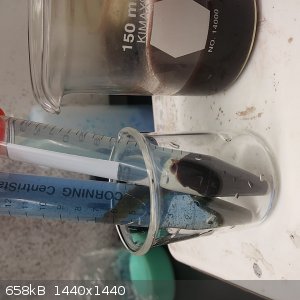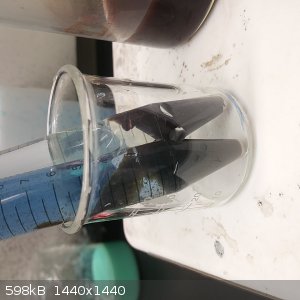VSEPR_VOID
National Hazard
   
Posts: 719
Registered: 1-9-2017
Member Is Offline
Mood: Fullerenes
|
|
Cupric Ferrocyanide-Ammonia Complex
A small sample of cupric ferrocyanide was prepared by first dissolving ~1g of hydroferrocyanic acid in 40 ml of distilled water and, with stirring,
neutralizing it with a mixture of aqueous sodium chloride and precipitated basic cupric carbonate.
15ml of the resulting red-brown solution was placed into a conical tube and centrifuged for 5 minutes.
In another tube, 15ml of the resulting red-brown solution were stirred with 50 ml household ammonia, surfactant free, and the solution poured into 100
ml of absolute ethanol. This tube was also centrifuged for five minutes.
In the photograph the right most beaker contains the original mixture of cupric ferrocyanide and salt, the right conical tube the first 15 ml of
solution centrifuged, and the leftmost tube the ammonia complex precipitate.
I can not find any documentation of a amine complex of cupric ferrocyanide. Did I just prepare something brand new?
[Edited on 1-5-2018 by VSEPR_VOID]
 
Within cells interlinked
Within cells interlinked
Within cells interlinked
|
|
|
VSEPR_VOID
National Hazard
   
Posts: 719
Registered: 1-9-2017
Member Is Offline
Mood: Fullerenes
|
|
Also does anyone know how to rotate the pictures 90 degrees?
Within cells interlinked
Within cells interlinked
Within cells interlinked
|
|
|
Boffis
International Hazard
    
Posts: 1836
Registered: 1-5-2011
Member Is Offline
Mood: No Mood
|
|
@Vsepr_void; why not just add sodium ferrocyanide solution to copper chloride solution in appropriate ratio per the concentration of the solution?
Where did you get/ how did you prepare hexacyanoferric acid (II)?
Can you crystallise your product, if so lets se some pictures.
How do you know you have an ammino complex? I suspect that ammonia solution will convert the gelatinous brown cupric ferrocyanide to a soluble
cuprammino salt and ammonium ferrocyanide though ferrocyanides are notorious for the formation of double salts; for examples ammonium calcium
ferrocyanide, so copper may form a similar double salt, which may or may not be soluble. Have you read any literature on ferrocyanides? I posted
references to a couple of really good books on the subject on another thread very recently.
I think the defining condition is the pH and the amount of free ammonia in solution but you lack of quantitive data makes it difficult to judge
anything.
|
|
|
VSEPR_VOID
National Hazard
   
Posts: 719
Registered: 1-9-2017
Member Is Offline
Mood: Fullerenes
|
|
I did read up on cupric ferrocyanide and its double salts. The substance presented is definitely not a sodium double salt due to color, the only other
cation present in solution. The literature says that the only way of preparing pure cupric ferrocyanide is by treating either calcium ferrocyanide
with cupric sulfate/chloride, or the reaction of hydroferrocyanic acid with either cupric hydroxide or basic carbonate. Thus why I prepared by cupric
ferrocyanide using the later method.
The sodium chloride present was there due to contamination of the basic cupric carbonate.
The hydroferrocyanic acid was prepared by the reaction of concentration HCl with potassium ferrocyanide. The white precipitate was washed with water
and dried.
I have not crystallized the product, I just made it a few hours ago and am out of the lab for now. That will be the next step; I will have to wash the
precipitate with ethanol (or acetone) and dry it. Once dry I will get some pics of it under the microscope.
I imagine that I can confirm the presence of ammonia and ferrocyanide by decomposing it and test to see if any gasses are released.
How would I tell if my salt is an amino complex rather than a ammonium double salt?
[Edited on 1-5-2018 by VSEPR_VOID]
Within cells interlinked
Within cells interlinked
Within cells interlinked
|
|
|
VSEPR_VOID
National Hazard
   
Posts: 719
Registered: 1-9-2017
Member Is Offline
Mood: Fullerenes
|
|
I found that the ammonia complex of cupric ferrocyanide has been prepared on YouTube. I still can not find any documentation on it.
https://www.youtube.com/watch?v=uaCMSBwhwUU
I really did not expect for no one to have prepared it, but I still have not seen anything written about it. If anyone has any ideas where to look
your advice it would be much appreciated. I have already checked HANDBOOK OF PREPARATIVE INORGANIC CHEMISTRY in the SM library and also The chemistry
of Cyanogen compounds and the manufacture and estimation by H E Williams (1915).
Next on my quest for a copper salt yet to be ever prepared I will try complexing my ferrocides (cupric ferrocyanide, cupric hydrogen ferrocyanide,
cupric sodium ferrocyanide, and curpic sodium oxyferrocyanide) with more exotic ligands.
The first step of this will be preparing and purifying larger amounts dry hydroferrocyanic acid and copper carbonate.
Within cells interlinked
Within cells interlinked
Within cells interlinked
|
|
|